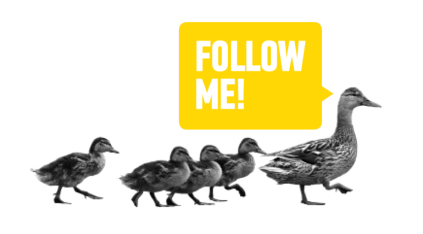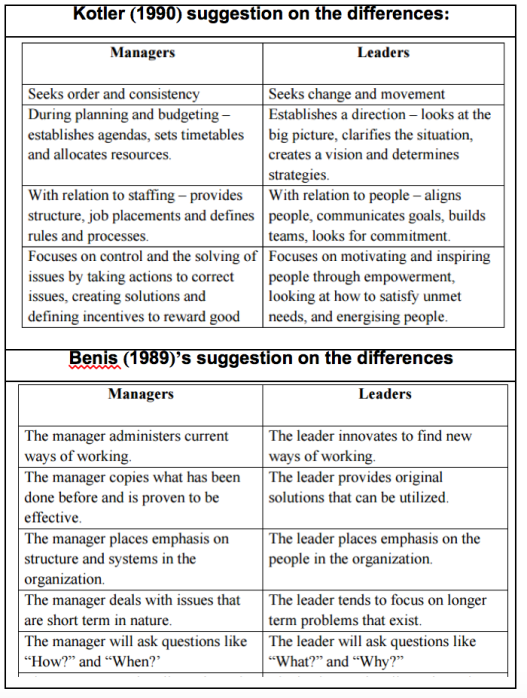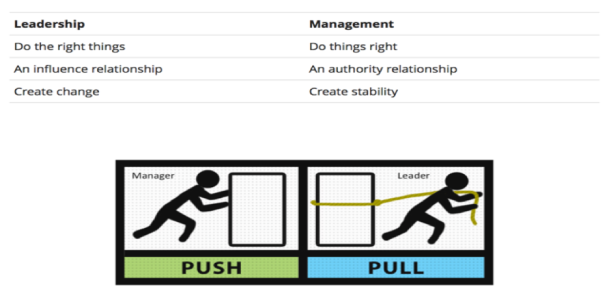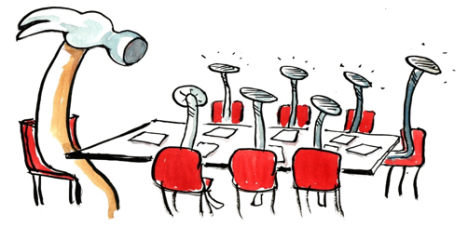Management and Leadership
Arguably a complicated topic of discussion simply due the vast number of similarities that one and the other (management and leadership) have amongst each other. However, it must be well understood that there are significant differences between one and the other. Blog 1 and 2 have demonstrated the concept of leadership and how they are living individuals who are trained and/or born to guide and lead. Kotler (1990) and Benis (1989) have come up with a series of distinctions that allows us to easily see how one and the other is different (Figure 1)

 Figure 1. Bennis (1989) and Kotter (1990) Leadership vs. Management
Figure 1. Bennis (1989) and Kotter (1990) Leadership vs. Management
[Source: Kotter 1990; Bennis 1989]
As noted in this figure, the differences are vast, starting with managers are often followers of the system established by leaders, and continue to progress in that same setting. Leaders on the other hand are more innovative, focus on change and continue to look for ways to improve working performance and company performance. Moreover, leaders are often those who set future goals, whereas managers set goals in between in order to attain the goals set by the leaders. To simplify these differences, the following figure is ideal:
 Figure 2. Push Pull differences between manager and Leader
Figure 2. Push Pull differences between manager and Leader
With that said, they are significant different, but they are similar in some ways too. For instance, a leader is likely to guide and nurture followers and so do the managers (Kubicek 2011). Both are capable of creating followers and both are capable of guiding (Kotter 2001).
Most Effective Approach to Managing Workplace
As CMI (2013) have suggested that management and leadership approach have swung past the traditional command and control structure to more democratic, participative and consultative approach is very much true. The rapidly rise in awareness is widely noted amongst the workplace subordinates and this is quite essential. Although, there are various theories that discuss the ample amount of management and leadership methods such as the Great Man Theory, Trait Theory, Behavioural theories, Situational leadership theory and many more. What we are seeing more and more common in the developed world is the use of situational leadership or a form of leadership where the leader attempts to adapt its style of leadership based on the situation. While in the meantime, the leader engages in transformational theory, looking towards more diplomacy, communication and understanding as they lead (Lawrence 2010). Command and control techniques are still widely noted in Asian countries, especially amongst Chinese-Thai textile companies in Thailand for instance. They are still widely run as a command and control format, with very strict regulations whereby workers are not led, but rather forced to follow by either tangible punishments or intangible. Such a leadership type is clearly noted in the cartoon figure below:

Figure 3. Type of leader that instils fear
[Source: Non-Profit Help n.d.]
Ideal Leaders
As CMI (2013) states that “there is no single ideal, as the best approach may vary according to circumstances and individual characteristics” is very much true. In fact, the most promising of all leaders are those who are capable of not only having their charm and other interpersonal features but also their ability to respond effectively in times of good and bad (Bryan and Hulme 2003). A leader that takes the first step, are those that are born to lead, whereas leaders who direct, are often not very effective these days. A leader is therefore a very crucial entity and very much important to the wellbeing of an organisation (Malik 2009).
For instance, Richard Branson falls under transformational leader, a leader that focuses in diplomacy, communication, relationships and also humour (Doshi n.d.; De Vries 1998). Such a leader is easily respected and are capable of winning the hearts of their followers. In addition to Richard Branson, I would say the most likely leader with situational style of leading is Steve Jobs that focuses on skills, relationship and dedication towards the company. We have noted there are several cases of leaders whereby they adapt their leadership style based on the situation, which is quite important because it is ultimately what affects the operational success of the company. A leader that very close to their staffs might somewhat guide them to become less focused at work, therefore at some given times the workplace code, behaviour and ethical requirement must be met. For this to happen, the leader might as well adapt their leadership style.
Therefore, I believe that the leader that is capable of adapting as per different situation is the best form of leader. A leader cannot stay persistent to the same format, and it is ultimately the requirement of the leader to ensure that their workers are well guided, well managed and high performing, while also ensuring the workers wellbeing are met, their psychological conditions are catered and so are their physical requirements. The following video would demonstrate more information regarding situational leadership and their benefits:
Figure 1. A basic explanation to leadership theory
List of References
- Bennis, W. (1989) Becoming a Leader, Philadelphia: Harper Paperbacks.
- Bryan, L. and Hulme, R. (2003) “Managing for improved corporate performance”, The McKinsey Quarterly, 3
- De Vries, K., and Manfred, F. R. (1998) Charisma in Action: The Transformational abilities of virgin’s Richard Brandson and ABB’s Percy Barnevik [online] available from <http://citeseerx.ist.psu.edu/viewdoc/download?doi=10.1.1.467.3374&rep=rep1&type=pdf>
- Doshi, R. (n.d.) Rupesh Doshi on Richard Branson [online] available from <http://worklife.wharton.upenn.edu/wp-content/uploads/2013/02/Rupesh-Doshi-on-Richard-Branson.pdf>
- Kotter, J. P. (1990) A Force For Change: How Leadership Differs from Management, Simon and Schluster, New York.
- Kotter, J. P., (2001) “What leaders really do?” Harvard Business Review, 79(11), .85 – 96.
- Kubicek, J. (2011) Leadership is Dead: How Influence is Reviving it, Howard Books, New York.
- Lawrence, P.R. (2010) Driven to Lead: Good, Bad and Misguided Leadership, John Wiley and Sons: San Francisco.
- Malik, F. (2009) Managing Performing Living: Effective Management for a New Era, Campus Verlag, Chicago.
- Non-Profit Help (n.d.) Trend 1: Which will change the way your association & Non-profit operates [online] available from <http://www.non-profithelp.com/blog/>
Impressive! Your blog gained me the knowledge of different styles of leadership.
LikeLike
Thank you so much!! hope you could apply with your real life
LikeLike
This is a good blog, you give a clear explain to the difference between leadership style and management style. And you also explain what is effective leadership in point. It is easily for reader to understand.
LikeLike
I’m happy that you like my article!!
LikeLike
aww girls you make me understand more of what’s the different between them!
Thanks ;)I appreciate that keep upload this kind of knowledge
Im your big fan
LikeLike
Thank you so much,I’m glad you like it.
LikeLike
The explanation about different leadership styles is quite clearly and easily to understand. You make me understand more of what’s the different between them! Thanks you.
LikeLike
I’m glad that this article help you to understand more about leadership and management
LikeLike
I appreciate that keep upload this kind of knowledge
I’m your big fan
LikeLike
Thank you so much
LikeLike
It is useful for all reader to apply with leadership style as well. I recommended that if you give more a real example of each leadership style, it will be excellent!
LikeLike
Thank you for your recommendation.
LikeLike
It is very clear structure and easy to understand. Thanks for sharing
LikeLike
Thank you so much
LikeLike
The application of these theories to the industry examples are well explained. Very nice work. Thank you for your good article.
LikeLike
I’m glad that you like it 🙂
LikeLike
The way that you combine theories, examples and your point of views are very good, it is easy and simple to understand
LikeLike
Thank you so much.I’m really happy to know that you liked my blog.
LikeLike
Well, this is a good article, you also provide the example to make it easy to understand the theory.
LikeLike
Thank you so much for your feed back
LikeLike